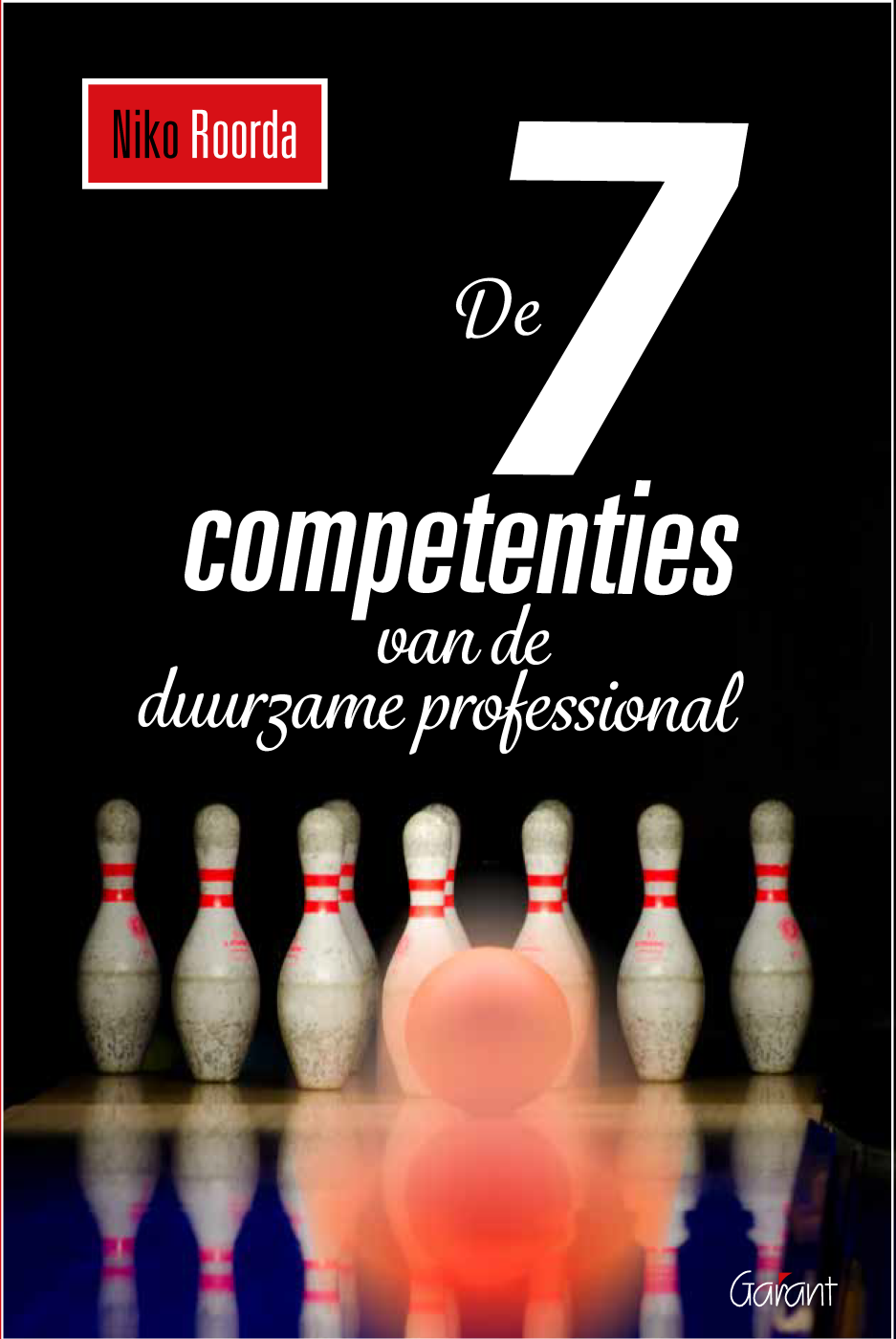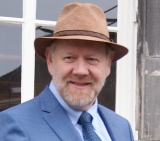RESFIA+D: Stories from sustainably competent professionals |
 During follow-up discussions of RESFIA+D assessments, it regularly emerged that participants would like to see some concrete examples of professionals who had exemplarily expressed certain competences in their work, making those competences more concrete for them.
During follow-up discussions of RESFIA+D assessments, it regularly emerged that participants would like to see some concrete examples of professionals who had exemplarily expressed certain competences in their work, making those competences more concrete for them.
 In response, Niko Roorda wrote a book in which, for each of the six general competences, and for each of the corresponding performances, a professional was found who indeed expressed that performance in an outstanding way. They were interviewed by Roorda, and their reports were provided with commentaries. The result is the Dutch book De Zeven Competenties van de Duurzame Professional, which is outlined elsewhere on this website.
In response, Niko Roorda wrote a book in which, for each of the six general competences, and for each of the corresponding performances, a professional was found who indeed expressed that performance in an outstanding way. They were interviewed by Roorda, and their reports were provided with commentaries. The result is the Dutch book De Zeven Competenties van de Duurzame Professional, which is outlined elsewhere on this website.
The book also presents a range of disciplinary competences, based considerable number of professionals explaining how they employ specific sustainability competences linked to their profession in their work.
The desire then arose to have such a book in English as well. For that purpose, Roorda approached his American colleague Anouchka Rachelson, who interviewed professionals in the United States and Canada.
The result was the book The Seven Competences of the Sustainable Professional, which can also be found elsewhere on this website.
Invitation to co-author
> If you would like to consider co-authoring a new book on the 7 competences in a language other than Dutch or English,
in the way Anouchka Rachelson did, please check this page:
The International 7 Competences Book Project and send an email to sustainability@roorda.nu.
Three stories
Here, on this page, are two excerpts from these books, related to general competences for sustainability. The first is taken directly from the English book; the second is translated from the Dutch book.
Another page tells the story of a particular disciplinary competence.
 Competence F: Future orientation
Competence F: Future orientation
Achievement F1: Think on different time scales, flexibly zooming in and out on short and long term approaches
Book: English edition, Section 8.1
It was an emerging crisis. As Miami Beach was bracing itself for yet another October king tide, when streets routinely flood even though no cloud is in sight, Mayor Philip Levine announced on the city’s public TV channel, “We have storms. We have rising sea level, due to climate change, but we’re taking the offensive, aggressive action to making sure our city is viable and livable for the next 500 years at a minimum.”
Position: Head of Resilience
The person at the center of helping Miami Beach realize these ambitious plans is the city’s new Chief Resiliency Officer, Susy Torriente. “I’m not an engineer and not a scientist,” Torriente says. “I’m a communicator and collaborator. I am giving our experts the tools we need.” Working both on an operational and a strategic level means she has to recognize interconnections, she says.
Ideally, short and long-term perspectives should be intertwined in a natural way. So how does one tackle long-term sustainability issues such as sea level rise? Torriente shares her approach: “These issues may be 50-100 years out, but in local government, you deal with a one-year budget and election cycles. The first plan I worked on was a five-year plan, but I would always bring it back to looking at short-term solutions and ask, how do you break it down into segments? It’s a matter of what’s doable.” Working in a political environment often means seizing opportunities when they arise, as different administrations can be more or less supportive. “When the stars align,” Torriente says, “it is time to push forward.”
Observe, listen, make connections
Torriente thinks that aside from being aware of how government works, a vital skill for city managers like her is to have the ability to zoom in and out to see the big picture. “You have to observe, listen to the experts, and make connections… I ask incoming young city interns to close their eyes and imagine the city in 30 years when they are going to be in the top position.” Innovation plays a significant role, too. “The need drives innovation,” Torriente believes. “We have to challenge ourselves, and we have to take risks. We’re writing the ‘textbook’ now. We need to train our staff and build capacity. In the face of climate change, we have to deliver services differently.” NOAA (National Oceanic and Atmospheric Association), for example, offers climate awareness training, she notes. Torriente also embraces creative solutions. In addition to traditional “gray infrastructure”, she increasingly promotes “green infrastructure, such as dunes and living shorelines” to create a natural environment that can protect residents.
| The achievement: You think on different time scales, distinguishing between a short-term and a long-term approach. This means:
|
|
When your roof leaks
Zooming in and out in time is easy to understand if you imagine the following situation: You are sitting quietly at home one night. Outside it is raining cats and dogs, but inside it feels nice and cozy until you suddenly realize that water is dripping from the ceiling. The roof is leaking! What do you do? Well, or course, the very first thing you do is get towels, wipe up the water, and place some buckets. The leaking roof is one thing, but you don’t want your costly hardwood floor or broadloom carpet to get ruined as well.
Next, you have to find the cause. Something is wrong with the roof. Maybe some roof tiles have shifted, or perhaps a watertight strip is no longer watertight. In other words, you find the cause and repair the damage. You might even take another big step and replace the entire roof, or as a last resort, you may find another house and move.
Wiping water up with towels and placing buckets – these are examples of short-term actions. They don’t address the causes, but they prevent further damage. This is what acting operationally means.
Repairing the roof represents a more profound approach. If you don’t do it, you will still be emptying buckets next year. It is a tactical approach, aimed at a longer term than the towel operation. It’s not a matter of minutes; rather, it takes days or weeks.
When you replace the roof or even move to another place altogether, then you apply a genuine long-term view. This is a strategic approach, which involves considering many issues, not just acute problems.
For example, you would ask yourself, “How do I want to live in twenty years?”
To put it a bit more formally:
|
How long is long term? It’s impossible to define it in an absolute sense; it depends on the context. For businesses or communities, the guidelines are as follows:
Many exceptions to these rules exist. For example, if the roof is leaking, repairs (= intermediate to long term) occur within a matter of days or weeks at the most – hopefully. |
|
A sustainably competent professional is able to oversee and connect these various terms, from short to long, in a harmonious way.
System orientation, Future orientation: two dimensions
Competence S, system orientation, deals with “Parts and wholes.” Chapter 6 describes how you zoom in and out within a system, from its details to a helicopter view and back. The same approach, alternating between the analytical and the holistic view, is not only needed within the dimension of space, but also with the other dimension: time.
Focusing on the immediate future (the king tide causing flooding next week) while also envisioning the future of the next generation (the predicted sea level rise over the coming decades means causeways and bridges need to be elevated) and being able to flexibly move from one time frame to the other – that is what a sustainable professional does.
This is not easy because the short term usually draws more attention than the long term. Many politicians look only to the next election, managers to the upcoming shareholder meeting, and employees to their approaching performance review. From sustainable professionals you may expect better. Do you remember the “rule of thumb for making sound decisions” in Chapter 2? It deals with the distinction between short and long term. The long-term consequences should always weigh in.
Someone who does not want to travel blindly toward the future, looks ahead and anticipates in order to reach an agreeable future. This is the very first principle of sustainable development.
 Competence A: Action Skills
Competence A: Action Skills
Achievement A3: Act when the time is right, and not against the flow: doing without doing
Book: Dutch edition, Section 12.3
Doing without doing: a beautiful paradox. It sounds like something that can't be done. But it is possible, because the first ‘doing’ means something different from the second. The first ‘doing’ stands for: getting something done, acting successfully. The second ‘doing’ means: forcing, applying pressure. So ‘doing without doing’ is: getting results without forcing. Or: acting at the right time, in an appropriate way.
‘Doing without doing’ is an expression that has been around for a long time. It comes from Chinese, where it sounds like ‘Wei wu wei’. In those words, the principle is found in the Tao te Ching, the famous book by the Chinese sage Lao Tse, the founder of Taoism, who lived between 600 and 500 BC.
The principle is simple to understand. Imagine a child sitting on a swing and asking you to push. You naturally do the first push when the child is sitting firmly. But the second and subsequent pushes? Prefer not to do those at the moment the child comes flying towards you at full speed. If you do, you will at least break the momentum and maybe even your wrists. The best thing to do is: wait until the swing is just about at its highest point, at the ‘dead’ point of the movement. At that point you give a small push, not much force is needed. A number of such pushes, always given at the right moment, add up to a great result. That is ‘doing without doing’.
Doing without doing is also like swimming in a river: going with the flow, not against it or across it. In short, using present forces and movements, instead of fighting against them.
Position: Chairman of the Social and Economic Council
An acknowledged master of ‘doing without doing’ is Alexander Rinnooy Kan. Among other things, he proved this between 2006 and 2012 as chairman of the SER, the Social and Economic Council of the Netherlands, the pre-eminent body of the famous Dutch polder model.
‘SER issues unanimous opinion on biobased economy’. The SER reported this to newspapers on 17 December 2010. The opinion was titled: ‘More chemistry between green and growth. The opportunities and dilemmas of a biobased economy'. The unanimity was a remarkable result, because the concept of the biobased economy, was - and still is - for many an unaccustomed concept, while at the same time it is fast becoming a pillar of sustainable development. ‘If the Netherlands invests in the biobased economy now,’ the press release reported, ’there are many opportunities for economic growth and a more sustainable society. The SER advocates promoting biomass sustainability worldwide, structurally stimulating innovation, opting for high-quality biomass application and properly preparing workers for new ways of working.’
The 33 members of the SER are very diverse: theory and practice meet. There are 11 representatives of employers' organisations, 11 on behalf of those of employees, and 11 crown members, appointed by the government on the basis of their expertise: almost without exception professors, like Rinnooy Kan.
Through its composition, the SER represents a broad base of support in Dutch society. The SER's conclusions and opinions, especially if they are unanimous, enjoy enormous prestige. A government of the Netherlands will not easily disregard such advice. If ministers do, it is a striking example of ‘swimming against the current’, and that is dangerous for any government.
One of the 11 Crown members chairs the council. In 2010, at the time of the opinion on biobased economy, it was Alexander Rinnooy Kan. In his six years as chairman, Rinnooy Kan got a lot done.
Shakespeare
I asked him whether he sees the unanimous opinions, which the ESC regularly manages to achieve, as an example of ‘doing without doing’, i.e. appropriate action at the right time. His answer began with a text from Shakespeare.
"There is a tide in the affairs of man, which taken at the flood leads on to fortune. This quote says it all: knots are there to be untangled, but also to be cut. This is tricky. In a complicated negotiation, there are a thousand reasons to wait a little longer, to consult further with this or that person, to weigh up further whether the balance of things is right. But then suddenly the tide has gone out and the opportunity is gone."
In other words, it is wise to wait until the time is right. But be careful not to let the moment pass you by, because then you will lose out. When the time comes: make your move! Rinnooy Kan:
"Timing, that's what it's all about. But also guts, and valuation skills. In that order, because there is no such thing as a faultless valuation, and those who do not dare to make a mistake condemn themselves to watching."
So dare to deal with uncertainties, because you will never get absolute certainty. Like the professionals who talked about their work earlier in this chapter, the former EEA chairman also stresses that it will always involve trade-offs that are far from easy.
"Is that which is before us morally justified, ethically defensible? Never one hundred per cent. Unavoidably, the world of inevitable compromises can only be depicted in shades of grey. You take a deep breath, and take your chances. You ask for a little leniency from everyone. You explain why that is reasonable, and important for the country. You show that you have listened carefully. You hope for the best. Sometimes you win. And sometimes you don't."
The role of chairman, of leader, is one of modesty. When you personally try to reap the harvest, to show how well you have done, you are likely to jeopardise the result so carefully obtained.
"The victory is to grant others," says Rinnooy Kan. "And defeat is to learn from."
| Achievement: You act when the time is right, and not against the flow: you ‘do without doing’. Meaning:
|
|
Dealing with resistances
An important reason for waiting for the right moment to do something is the presence of resistances. These may be present in individuals or groups. But resistances can also be caused by the timing of physical systems, e.g. industrial processes, delivery times (not ‘just in time’), biological systems, train cancellations or traffic jams, the weather or the season.
Resistances are sometimes wrapped up in ‘excuses’. As a consultant, for instance, I have repeatedly been told by managers that now was not a good time to introduce sustainability or CSR, "... because the organisation is just now in a change process". Other managers, at other times, told me, "... because the organisation is just now not in a change process".
If you determine, at what moment the resistance of people or groups is at its lowest, you obviously don't do this by abusing the circumstances, for example at a moment when those involved are absent (e.g. due to holidays) or weak (e.g. due to illness, fatigue or divided attention). What you can do is, for example: wait until support among those involved has grown or until those involved are in an appropriate mood or situation to consider the activities clearly. Or actively facilitate the decision-making process. For example, by: providing information. Removing misunderstandings. Actively listening to objections. Looking for alternatives together. Setting up preparatory activities (‘plough the land before sowing’), in such a way that resistances are reduced rather than increased. Opening or reopening discussions, involving all stakeholders in an equal way.

